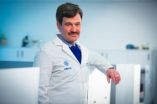(Press-News.org) Striving for the protein equivalent of the Human Genome Project, an international team of researchers has created an initial catalog of the human "proteome," or all of the proteins in the human body. In total, using 30 different human tissues, the team identified proteins encoded by 17,294 genes, which is about 84 percent of all of the genes in the human genome predicted to encode proteins.
In a summary of the effort, to be published May 29 in the journal Nature, the team also reports the identification of 193 novel proteins that came from regions of the genome not predicted to code for proteins, suggesting that the human genome is more complex than previously thought. The cataloging project, led by researchers at The Johns Hopkins University and the Institute of Bioinformatics in Bangalore, India, should prove an important resource for biological research and medical diagnostics, according to the team's leaders.
"You can think of the human body as a huge library where each protein is a book," says Akhilesh Pandey, M.D., Ph.D., a professor at the McKusick-Nathans Institute of Genetic Medicine and of biological chemistry, pathology and oncology at The Johns Hopkins University and the founder and director of the Institute of Bioinformatics. "The difficulty is that we don't have a comprehensive catalog that gives us the titles of the available books and where to find them. We think we now have a good first draft of that comprehensive catalog."
While genes determine many of the characteristics of an organism, they do so by providing instructions for making proteins, the building blocks and workhorses of cells, and therefore of tissues and organs. For this reason, many investigators consider a catalog of human proteins — and their location within the body — to be even more instructive and useful than the catalog of genes in the human genome.
Studying proteins is far more technically challenging than studying genes, Pandey notes, because the structures and functions of proteins are complex and diverse. And a mere list of existing proteins would not be very helpful without accompanying information about where in the body those proteins are found. Therefore, most protein studies to date have focused on individual tissues, often in the context of specific diseases, he adds.
To achieve a more comprehensive survey of the proteome, the research team began by taking samples of 30 tissues, extracting their proteins and using enzymes like chemical scissors to cut them into smaller pieces, called peptides. They then ran the peptides through a series of instruments designed to deduce their identity and measure their relative abundance.
"By generating a comprehensive human protein dataset, we have made it easier for other researchers to identify the proteins in their experiments," says Pandey. "We believe our data will become the gold standard in the field, especially because they were all generated using uniform methods and analysis, and state-of-the-art machines."
Among the proteins whose data patterns have been characterized for the first time are many that were never predicted to exist. (Within the genome, in addition to the DNA sequences that encode proteins, there are stretches of DNA whose sequences do not follow a conventional protein-coding gene pattern and have therefore been labeled "noncoding.") The team's most unexpected finding was that 193 of the proteins they identified could be traced back to these supposedly noncoding regions of DNA.
"This was the most exciting part of this study, finding further complexities in the genome," says Pandey. "The fact that 193 of the proteins came from DNA sequences predicted to be noncoding means that we don't fully understand how cells read DNA, because clearly those sequences do code for proteins."
Pandey believes that the human proteome is so extensive and complex that researchers' catalog of it will never be fully complete, but this work provides a solid foundation that others can reliably build upon.
INFORMATION:
Authors of the report include Min-Sik Kim and others from the Johns Hopkins University School of Medicine, Harsha Gowda and others from the Institute of Bioinformatics, and others from several other institutions.
This work was supported by funds from the National Institute of General Medical Sciences (U54GM103520, P41GM103504), the National Cancer Institute (U24CA160036), the National Heart, Lung and Blood Institute (HHSN268201000032C), the Sol Goldman Pancreatic Cancer Research Center, India's Council of Scientific and Industrial Research and Wellcome Trust/DBT India Alliance.
Additional Resources:
Link to article in Nature (live after embargo lifts): http://dx.doi.org/10.1038/nature13302
Interactive tool: http://www.humanproteomemap.org
Pandey Lab: http://pandeylab.igm.jhmi.edu/
Media Contacts: Catherine Kolf; 443-287-2251; ckolf@jhmi.edu
Vanessa McMains; 410-502-9410; vmcmain1@jhmi.edu
Shawna Williams; 410-955-8236; shawna@jhmi.edu
Extensive cataloging of human proteins uncovers 193 never known to exist
Important resource for speeding research and diagnostic development
2014-05-28
ELSE PRESS RELEASES FROM THIS DATE:
New study finds Antarctic Ice Sheet unstable at end of last ice age
2014-05-28
CORVALLIS, Ore. – A new study has found that the Antarctic Ice Sheet began melting about 5,000 years earlier than previously thought coming out of the last ice age – and that shrinkage of the vast ice sheet accelerated during eight distinct episodes, causing rapid sea level rise.
The international study, funded in part by the National Science Foundation, is particularly important coming on the heels of recent studies that suggest destabilization of part of the West Antarctic Ice Sheet has begun.
Results of this latest study are being published this week in the journal ...
Major discovery on the mechanism of drug resistance in leukemia and other cancers
2014-05-28
A mechanism that enables the development of resistance to Acute Myeloid Leukemia (AML) anticancer drugs, thereby leading to relapse, has been identified by Kathy Borden of the University of Montreal's Institute for Research in Immunology and Cancer (IRIC) and her collaborators. Kathy Borden is a Principal Investigator at IRIC and a professor at the university's Department of Pathology and Cell Biology. The development of drug resistance is one of the main problems in clinical oncology and the cause of relapse in many patients.
The new discovery, recently published in ...
NASA's TRMM and Aqua satellites peer into Tropical Storm Amanda
2014-05-28
Hurricane Amanda has weakened to a tropical storm, but not before NASA's TRMM satellite took a look under its clouds at the rate of heavy rainfall it was generating. After weakening to a tropical storm, NASA's Aqua satellite identified that those strong thunderstorms were limited to the area around the center of its circulation.
The Tropical Rainfall Measuring Mission satellite known as TRMM passed over Amanda on Saturday May 24, 2014 at 2150 UTC (5:50 p.m. EDT). TRMM is a joint mission between NASA and the Japan Aerospace Exploration Agency known as JAXA.
At NASA's ...
Wild coho may seek genetic diversity in mate choice
2014-05-28
CORVALLIS, Ore. – A new study by researchers at Oregon State University suggests that wild coho salmon that choose mates with disease-resistant genes different from their own are more likely to produce greater numbers of adult offspring returning to the river some three years later.
The researchers also found that hatchery-reared coho – for some unknown reason – do not appear to have the same ability to select mates that are genetically diverse, which may, in part, explain their comparative lower reproductive success.
Results of the study have been published in this ...
Increased social network can have big payoff for nonprofits, study shows
2014-05-28
BUFFALO, N.Y. — Charitable fundraising once depended primarily upon a charity's size, efficiency and longstanding reputation. That was before Razoo, Chipin, Facebook and Twitter came to town.
In the first academic study to look at what determines charitable giving on social-media sites, researchers found that those media have created a more level playing field in the nonprofit world, one in which successful use of technology can make up for limited organizational size.
Technology and social media, it turns out, can not only raise the online profile of even small organizations, ...
How long should HCV treatment last? Study suggests answers are complex
2014-05-28
BUFFALO, N.Y. – As new treatments for hepatitis C virus (HCV) are approved, biomedical scientists are exploring their mechanisms and what they reveal about the virus. An online publication this month in Hepatology is the first to report real-time tracking of viral decay in the liver and blood in 15 patients with HCV.
Led by Andrew H. Talal, MD, University at Buffalo professor of medicine in the Division of Gastroenterology, Hepatology and Nutrition and corresponding author, the study is the first to trace in real-time how the drug telaprevir inhibits viral replication ...
Study affirms value of epigenetic test for markers of prostate cancer
2014-05-28
A multicenter team of researchers report that a commercial test designed to rule out the presence of genetic biomarkers of prostate cancer may be accurate enough to exclude the need for repeat prostate biopsies in many — if not most — men.
"Often, one biopsy is not enough to definitively rule out prostate cancer," says study researcher Jonathan Epstein, M.D., director of the Division of Surgical Pathology and a professor of pathology, urology and oncology at the Johns Hopkins University School of Medicine. "Our research finds that by looking for the presence or absence ...
Women's contraceptive use influenced by contraception education and moral attitudes
2014-05-28
COLUMBIA, Mo. – Nearly half of all pregnancies in the United States are unintended, and unplanned pregnancies are associated with poorer health and lower rates of educational and economic achievement for women and their children, according to the Centers for Disease Control and Prevention. However, research shows that the desire to avoid pregnancy does not necessarily increase women's use of contraceptives, although this discrepancy is not well understood. Now, MU researchers have found that levels of prior sex education and moral attitudes toward contraception influence ...
Toxins in the environment might make you older than your years
2014-05-28
Why are some 75-year-olds downright spry while others can barely get around? Part of the explanation, say researchers writing in the Cell Press journal Trends in Molecular Medicine on May 28, is differences from one person to the next in exposure to harmful substances in the environment, chemicals such as benzene, cigarette smoke, and even stress.
While the birth date on your driver's license can tell you your chronological age, that might mean little in terms of the biological age of your body and cells. The researchers say that what we need now is a better understanding ...
Cocktail party neuroscience: Making sense of voices in a crowd
2014-05-28
This news release is available in French. Listening to a conversation in the context of a cocktail party presents a great challenge for the auditory system. Without realizing it, one must extract, from a complex mixture of sound, the sound of a single voice to understand and track it. Researchers at Queen's University, lead by Dr. Ingrid Johnsrude, are studying how our brains meet that challenge, and allow us to distinguish specific voices in crowded, noisy and distracting environments. Her studies have revealed that the brain does not simply rely on the incoming ...
LAST 30 PRESS RELEASES:
New expert guidance urges caution before surgery for patients with treatment-resistant constipation
Solar hydrogen can now be produced efficiently without the scarce metal platinum
Sleeping in on weekends may help boost teens’ mental health
Study: Teens use cellphones for an hour a day at school
After more than two years of war, Palestinian children are hungry, denied education and “like the living dead”
The untold story of life with Prader-Willi syndrome - according to the siblings who live it
How the parasite that ‘gave up sex’ found more hosts – and why its victory won’t last
When is it time to jump? The boiling frog problem of AI use in physics education
Twitter data reveals partisan divide in understanding why pollen season's getting worse
AI is quick but risky for updating old software
Revolutionizing biosecurity: new multi-omics framework to transform invasive species management
From ancient herb to modern medicine: new review unveils the multi-targeted healing potential of Borago officinalis
Building a global scientific community: Biological Diversity Journal announces dual recruitment of Editorial Board and Youth Editorial Board members
Microbes that break down antibiotics help protect ecosystems under drug pollution
Smart biochar that remembers pollutants offers a new way to clean water and recycle biomass
Rice genes matter more than domestication in shaping plant microbiomes
Ticking time bomb: Some farmers report as many as 70 tick encounters over a 6-month period
Turning garden and crop waste into plastics
Scientists discover ‘platypus galaxies’ in the early universe
Seeing thyroid cancer in a new light: when AI meets label-free imaging in the operating room
Neutrophil-to-lymphocyte ratio may aid risk stratification in depressive disorder
2026 Seismological Society of America Annual Meeting
AI-powered ECG analysis offers promising path for early detection of chronic obstructive pulmonary disease, says Mount Sinai researchers
GIMM uncovers flaws in lab-grown heart cells and paves the way for improved treatments
Cracking the evolutionary code of sleep
Medications could help the aging brain cope with surgery, memory impairment
Back pain linked to worse sleep years later in men over 65, according to study
CDC urges ‘shared decision-making’ on some childhood vaccines; many unclear about what that means
New research finds that an ‘equal treatment’ approach to economic opportunity advertising can backfire
Researchers create shape-shifting, self-navigating microparticles
[Press-News.org] Extensive cataloging of human proteins uncovers 193 never known to existImportant resource for speeding research and diagnostic development




